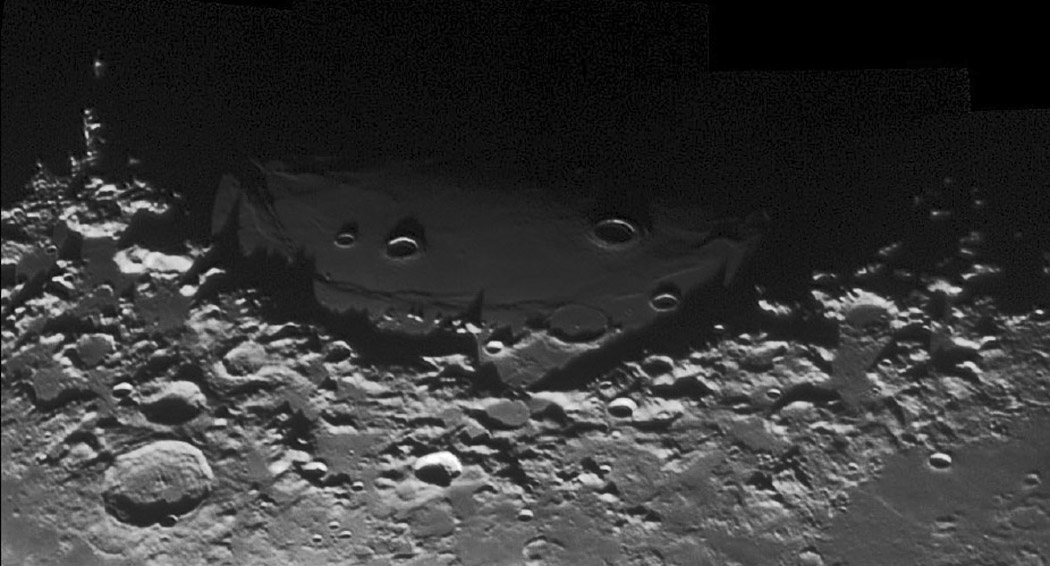Difference between revisions of "October 24, 2012"
| Line 1: | Line 1: | ||
__NOTOC__ | __NOTOC__ | ||
=Stepping Down= | =Stepping Down= | ||
| − | |||
<!-- ws:start:WikiTextHeadingRule:0:<h1> --> | <!-- ws:start:WikiTextHeadingRule:0:<h1> --> | ||
<!-- ws:start:WikiTextLocalImageRule:6:<img src="/file/view/LPOD-Oct24-12.jpg/375837900/LPOD-Oct24-12.jpg" alt="" title="" /> -->[[File:LPOD-Oct24-12.jpg|LPOD-Oct24-12.jpg]]<!-- ws:end:WikiTextLocalImageRule:6 --><br /> | <!-- ws:start:WikiTextLocalImageRule:6:<img src="/file/view/LPOD-Oct24-12.jpg/375837900/LPOD-Oct24-12.jpg" alt="" title="" /> -->[[File:LPOD-Oct24-12.jpg|LPOD-Oct24-12.jpg]]<!-- ws:end:WikiTextLocalImageRule:6 --><br /> | ||
| − | <em>image by [mailto:rhill@lpl.arizona.edu Rik Hill], Tucson, Arizona</em><br /> | + | <em>image by [mailto:rhill@lpl.arizona.edu" rel="nofollow Rik Hill], Tucson, Arizona</em><br /> |
<br /> | <br /> | ||
| − | I think of the Apennines as having dramatic long shadows, as do the Caucusus and Alpes, but Crisium? Rik nicely demonstrates, yep, Crisium. too. In fact, almost anywhere mountains loom over plains, spiky shadows are possible with low enough illumination. Beyond the long shadows, narrow shadows reveal the concentric maria ridges that mark the edge of the Crisium bench. The Path tool of [http://target.lroc.asu.edu/da/qmap.html?mv=eqc&mcx=1577234.61827&mcy=548758.97268&mz=7 QuickMap] shows for the ridge near Peirce and Swift that the topography rises slowly by about 100 m approaching the ridge and then quickly drops off by 400 m or more - the area inside the ridge is thus about 300 m lower than the bench; the ridge is a fault.<br /> | + | I think of the Apennines as having dramatic long shadows, as do the Caucusus and Alpes, but Crisium? Rik nicely demonstrates, yep, Crisium. too. In fact, almost anywhere mountains loom over plains, spiky shadows are possible with low enough illumination. Beyond the long shadows, narrow shadows reveal the concentric maria ridges that mark the edge of the Crisium bench. The Path tool of [http://target.lroc.asu.edu/da/qmap.html?mv=eqc&mcx=1577234.61827&mcy=548758.97268&mz=7" rel="nofollow QuickMap] shows for the ridge near Peirce and Swift that the topography rises slowly by about 100 m approaching the ridge and then quickly drops off by 400 m or more - the area inside the ridge is thus about 300 m lower than the bench; the ridge is a fault.<br /> |
<br /> | <br /> | ||
| − | <em>[mailto:tychocrater@yahoo.com Chuck Wood]</em><br /> | + | <em>[mailto:tychocrater@yahoo.com" rel="nofollow Chuck Wood]</em><br /> |
<br /> | <br /> | ||
<strong>Technical Details</strong><br /> | <strong>Technical Details</strong><br /> | ||
Revision as of 22:37, 4 January 2015
Stepping Down

image by " rel="nofollow Rik Hill, Tucson, Arizona
I think of the Apennines as having dramatic long shadows, as do the Caucusus and Alpes, but Crisium? Rik nicely demonstrates, yep, Crisium. too. In fact, almost anywhere mountains loom over plains, spiky shadows are possible with low enough illumination. Beyond the long shadows, narrow shadows reveal the concentric maria ridges that mark the edge of the Crisium bench. The Path tool of " rel="nofollow QuickMap shows for the ridge near Peirce and Swift that the topography rises slowly by about 100 m approaching the ridge and then quickly drops off by 400 m or more - the area inside the ridge is thus about 300 m lower than the bench; the ridge is a fault.
" rel="nofollow Chuck Wood
Technical Details
Oct 3, 2012, 0645 UT. Tec 8" f/30 Mak-Cass + DMK21AU04 + 656.3 nm filter. Registax6 and GIMP for processing the images and combined with AutoStitch.
Related Links
Rükl plate 26



